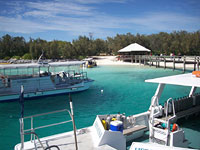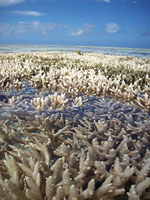

 | |||||||||||||
|
|
Journals 2008/2009Zamaria Rocio
August 25, 2008 I was up early today and very excited about starting my adventure. I had only one leg left in my trip before I reached my final destination, Heron Island. I got down to Gladstone's harbor for the 11 o'clock boat to the island.
It was there I first starting meeting some of the scientists that were associated with the Australian CReefs program and who would be staying with me on Heron Island. CReefs stands for the Census of Coral Reefs. It is just one of seventeen projects of the Census of Marine Life (see www.creefs.org). The Australian Institute of Marine Science (AIMS) is in charge of getting the scientists who will sample and analyze the coral reef's biodiversity. They are doing this at three different sites around Australia for four years. The sites are Ninglaoo Reef in Western Australia, the Great Barrier Reef's Heron and Lizard Island. The data collected will be available for the public through the Ocean Biogeographic Information System (see www.iobis.org). Dr. Julian Caley, AIMS research scientist, is the project's leader. You will hear more about him later. We were on that high-speed boat for two hours but it was worth it. Seeing the island and this area for the first time was just awesome. The clear water was so blue-blue, and the coarse sand so white. Nothing I was use to in San Diego. Also, keep in mind it's winter here!
The island is shared by three groups; the Voyages Resort, the University of Queenland's research station, and the Queensland Parks and Wildlife Ranger Station. We were met by a ranger and given a quick orientation to this island and told about this World Heritage-Listed Marine Park. Everything here, the flora and the fauna, is protected. After orientation, I went on my first reef walk. I was amazed at all the "stuff" I could see without going snorkeling: algae, lots of invertebrates, fish, and even a leopard shark.
Question to you before tomorrow's journal entry: Exactly where in the world is Heron Island and why is it important to study the reef there? |
||||||||||||


